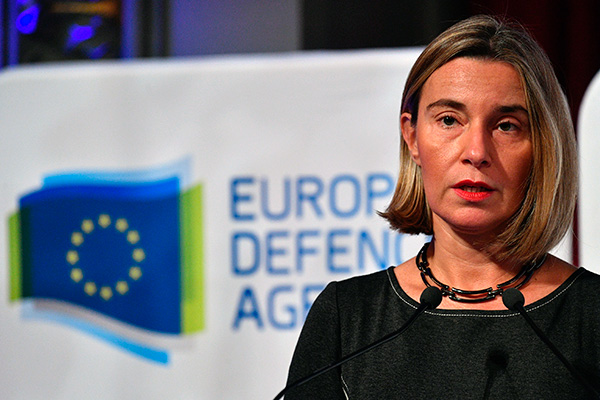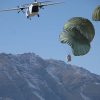Theme
As part of the 2016 EU Global Strategy implementation, the EU launched a series of new initiatives to boost European defence cooperation through improved joint planning, development, procurement and operation of capabilities: the Coordinated Annual Review on Defence (CARD), the Permanent Structured Cooperation (PESCO) and the European Defence Fund (EDF). A coherent, priority-focused and output-oriented implementation of the new tools is indispensable to achieve the objective. The European Defence Agency (EDA) plays an important role in this respect.
Summary
The year 2017 has seen the launch of ambitious new EU tools on defence (CARD, PESCO, European Defence Fund) which now need to be implemented in a coherent and coordinated manner to make sure they complement each other, focus on capability priorities identified in the Capability Development Plan (CDP), involve industry and lead to joint projects which produce tangible, operational outcome in the form of an improved pool of forces and defence assets for Member States. As the secretariat for both CARD and PESCO (together with the EEAS and EUMS), the central operator for EU-funded defence activities and a privileged interlocutor and promotor of the European defence technological and industrial base, the European Defence Agency (EDA) is actively involved in all the initiatives with the aim of ensuring coherence, efficiency and a steady focus on capability priorities.
Analysis1
These are exciting times for European defence. Reinvigorated by the 2016 EU Global Strategy, defence has risen to the top of the EU’s priorities. A series of bold and truly unprecedented initiatives were launched in 2017 to boost defence cooperation through improved joint planning and prioritisation, development, procurement and operation of capabilities among Member States. The Coordinated Annual Review on Defence (CARD), the Permanent Structured Cooperation (PESCO) and the European Defence Fund (EDF), as well as a brushed-up and expanded EU-NATO cooperation built on the 2016 Joint Declaration, are all central pieces of a new defence puzzle in the making which, if correctly assembled, can provide EU Member States with better and more interoperable and cost-efficient defence capabilities.
The momentum created by these initiatives also offers a unique opportunity to overcome the national fragmentation of the European defence market affecting the industry’s competitiveness and impeding efforts to consolidate Europe’s defence sector. A robust, globally competitive defence technological and industrial base is indispensable if the aim is to strengthen Europe’s defence and reach the strategic autonomy objective set out in the EU Global Strategy.
Developing a more collaborative defence culture in Europe, underpinned by joint capability programmes and a strong industry, will take time. Important steps have been made in this direction with the launch of the recent defence initiatives.
Now it is time for their implementation because inventing and setting up new tools, however ground-breaking, is not enough. Equally crucial is how they are used and whether they deliver the expected results.
CARD, PESCO and EDF must interlock and complement each other in a coherent and coordinated manner. Ultimately, they must lead to joint projects and concrete output which genuinely respond to Member States’ capability priorities. The ambition must be to fill existing critical defence capability gaps in Europe and produce tangible, operational outcome in the form of an improved pool of forces and defence assets.
This requires close cooperation with industry, which must be innovative enough to develop the top-notch capabilities required by the Member States’ Armed Forces, now and in the future. Hence the need for a coherent, priority-driven and industry-supported implementation of all three initiatives.
This is where the European Defence Agency (EDA) comes into play. As the secretariat for both CARD and PESCO (together with the European External Action Service, EEAS, and the EU Military Staff, EUMS) as well as a central operator for EU-funded defence activities, the Agency is called to leverage its expertise and networks to ensure coherence, efficiency and a steady focus on capability priorities. EDA is prepared for this new task.
As a result of the Agency’s Long-Term Review (LTR) launched in 2016, Defence Ministers agreed in May 2017 to reinforce EDA’s mission on three crucial aspects. First, as the main intergovernmental prioritisation instrument at the EU level in support of defence capability development. With its Capability Development Plan (CDP, currently under revision) and its Overarching Strategic Research Agenda (OSRA), EDA is ideally suited for this task. Secondly, as the preferred cooperation forum and management support structure at the EU level for participating Member States to engage in technology and capability development activities. EDA has 12 so-called Capability Technology groups (CapTechs) gathering experts from Member States, industry and research organisations. Today, it manages no less than 97 ad hoc Research & Technology (R&T) and capability projects, 14 R&T and capability programmes, three joint procurement arrangements and more than 190 other activities related to capability development, R&T and the defence industry. Last but not least, it acts as the interface (coordinating military views in wider EU policies) and the central operator with regard to EU funded defence-related activities. Entrusted by the Commission to implement important EU programmes such as the Preparatory Action on Defence Research (PADR) and the Consultation Forum for Sustainable Energy in Defence, the Agency has already a solid track record in this domain.
All in all, the Long-Term Review conclusions are a strong signal that Member States trust the Agency to play a central role in the new EU defence set-up, also echoing the EU Global Strategy’s call to make ‘full use’ of the EDA’s potential. Being a small and flexible agency, it has already shifted staff and resources to adapt to new priorities, for instance with the setting up of a dedicated CARD team and a PESCO Task Force.
But what is the Agency’s involvement in the new EU initiatives, and why does it matter?
Starting with CARD, the aim of the annual review, which is currently in a test phase (until the end of 2018), is to foster a gradual synchronisation and mutual adaptation of Member States’ national defence planning cycles and capability development practices, in the hope that this will lead to more systematic defence cooperation in Europe. For CARD to provide a realistic picture of Europe’s capability landscape, it is crucial to have the most up-to-date and detailed information possible collected from national MoDs on defence plans, including spending. The responsibility for information gathering lies with EDA, which, supported by the EUMS, is currently engaged in bilateral dialogues with Member States. Once collected, the information will be compiled by the Agency in a comprehensive CARD analysis report to Ministers that will include concrete recommendations for further defence cooperation. Lessons learnt from the trial run will be incorporated into the first full CARD cycle scheduled to take place from 2019 to 2020.
Directly linked to CARD is PESCO, in which 25 EU Member States decided to participate. For the first time ever, European MoDs are engaging in collaborative capability development projects based on ambitious and binding commitments. Here too, EDA acts as a secretariat with a supporting role at various levels.
First, in close cooperation with the European External Action Service (EEAS), including the EUMS, it serves as a platform where PESCO-participating Member States nations can identify, assess and consolidate possible projects. It was in this context and at the request of Member States that the Agency supported the assessment of the first set of 17 PESCO projects formally approved by Ministers on 6 March. EDA’s input at an early stage of project assessment helps to ensure there is no unnecessary duplication with existing initiatives, also in other institutional contexts. This is crucial because we want and need to move away from a culture of duplication of efforts to more interoperability.
Secondly, EDA can support the practical PESCO project implementation at the request of Member States. This role is particularly well suited to the Agency as PESCO’s two-layer approach is similar to the project governance structure in EDA: Member States have full control of the project content, with the Agency serving participating nations as a facilitator and service provider.
Thirdly, EDA will play a leading role in the annual assessment of PESCO nations’ contributions and respect of the binding commitments.
The practical implementation of the European Defence Fund (EDF) also relies to a large extent on EDA both in the research and capability domains. The Fund will coordinate, supplement and amplify national investments in defence research, in the development of prototypes and in the acquisition of defence equipment and technology.
The research window of the Fund will benefit from the lessons already learnt from the Pilot Project and the Preparatory Action on Defence Research, both managed and implemented by EDA on the basis of a Commission mandate. For the first time, through the Preparatory Action, the EU offer grants for collaborative research in innovative defence technologies and products, fully and directly funded from the EU budget: €90 million for the period 2017-2019. In 2018, the Commission intends to propose a dedicated EU Defence Research Programme (EDRP) for the period beyond 2020 with an annual budget of €500 million. This would make the EU one of the biggest defence research investors in Europe! The EDRP will mark a fundamental change in approach and be testimony to Europe’s commitment to do more for defence research, and to do it together. However, boosting joint defence research through the EDF’s research window (Preparatory Action now, EDRP in the future) only makes sense if the results are taken up and further developed under the Fund’s second leg: the capability window.
That is where the new European Defence Industrial Development Programme (EDIDP) will be key. First, because it offers unprecedented EU incentives –grants, financial instruments and public procurement– in support of cooperation between undertakings in the very important development phase of defence products and technologies: definition of common technical specifications, prototyping, testing, qualification and certification of new and updated defence products, as well as feasibility studies and other support activities. Only collaborative projects involving several Member States will be eligible, and a proportion of the overall budget will be earmarked for projects involving cross-border participation of SMEs. Secondly, because EDIDP’s planned budget is substantive: €500 million for 2019-20, with the prospect of an even more substantial follow-up programme under the EU’s next Multiannual Financial Framework with an estimated annual budget of €1 billion. Depending on the use of the different co-funding rates foreseen in the regulation, EDIDP could leverage Member-State funding with an expected multiplying effect of five, potentially generating total investments in defence capability development of €5 billion per year after 2020.
A budget this size opens totally new prospects for collaborative capability development at European level, which bodes well for the future. But it involves a heavy responsibility: ‘too big to fail’, EDIDP must deliver. It cannot dwindle into an EU subsidy scheme for industry but must serve capability priorities identified at the European level in the Capability Development Plan (CDP). And it must benefit all Member States, big and small. Failure to do so could lead to EDIDP developing technologies or equipment that nobody needs and no MoD will buy. Hence the need for a capability priority focused implementation of EDIDP, with close involvement of EDA.
The Agency already plays a key upstream role by contributing to EDIDP work and supporting Member States to achieve a common understanding of the EU added value of cooperative projects or topics that they may consider for the EDIDP work programme. It involves strong synergies with the Agency’s prioritisation support role in PESCO and CARD, closing the circle.
The circle would not be fully closed, however, without recalling the overarching role and importance of the Capability Development Plan which remains the baseline of European collaborative capability development and the only prioritisation tool at the European level. Based on the EU Military Committee’s (EUMC) inputs, the CDP integrates the general shortfalls and risks identified to achieve military objectives, also taking into account operational aspects and the end-users’ views. It also takes into account the coherence with national plans and with NATO’s Defence Planning Process. Entrusted by Member States, EDA is the architect of the current CDP revision set to be approved in June. The revised CDP will feed CARD and PESCO and, if it is to remain coherent, should also guide future projects under the EDF.
The industry’s importance in translating Europe’s defence ambitions into action cannot be stressed enough. Aiming at strategic autonomy is more than a political or military objective; it is first and foremost a technological-industrial challenge as it implies the ability for Europe to develop, modify, operate and replace the required defence capabilities. The approach must therefore be capability AND technology driven. Both matter and must go hand in hand. What good are capability priorities agreed at the EU level if industry lacks the required technological know-how to develop, produce and deliver them? And how useful are the most cutting-edge defence technologies and systems developed by industry if they fail to fit the Armed Forces’ operational needs?
Europe’s strategic autonomy stands and falls on the quality and depth of its defence technological-industrial base. The latter, in turn, depends on how Member States and EU institutions engage and cooperate with industry. In the past, the standard division of roles was clear from the outset: Ministries of Defence came up with capability wish-lists which industry was asked to turn into reality, ie, into operational assets. Today, at a time of fast technological change, the cast is shifting. Whereas in the past, critical technology often emerged from the military first before being turned into civil-industrial applications, the trend has dramatically reversed: cutting-edge, high-tech innovations, including those with potential for military applications (think, for example, of Artificial Intelligence or Unmanned Systems), are driven by the civil commercial sector with start-ups and high-tech companies spending amounts on R&T which cannot be matched by the military. Already now, and even more so in the future, the quality of Europe’s defence capabilities depends on the military’s ability to engage and partner with the high-tech corporate world to develop new disruptive applications for the future. EDA’s different Capability Technology groups (CapTechs), which form an extensive network of experts from participating Member States and European industry dedicated to a particular technology area, offer an ideal and unparalleled framework to do exactly that.
Beyond that, support for and engagement with industry is a core mission of EDA since its creation in 2004. Based on a task entrusted by Defence Ministers (EDA Steering Board) in November 2016, the Agency developed a new structured dialogue and enhanced engagement with industry –not only prime companies but also national defence industry associations and SMEs–. The focus is on priority areas such as capability development, R&T, Single European Sky (SES) and Key Strategic Activities. The latter, Key Strategic Activities (KSA), are vital to ensure an appropriate level of European strategic autonomy. EDA was given the task by Member States to identify the core skills, technologies and manufacturing capabilities that must be safeguarded and supported on EU soil so that Member States investments and available EU funding can be directed more efficiently to supporting them. Importantly, the KSAs are identified out of the Overarching Strategic Research Agenda (OSRA) and CDP priorities, which provide the basis for joint capability development.
EDA makes sure industry is and remains closely involved throughout the KSA process whose outcome, together with the updated CDP priorities, will be a core ingredient for the first official CARD 2019, if so agreed. Together they should also guide the project selection under the EDF ensuring EU funding is only used for collaborative capability projects serving Europe’s needs and strategic autonomy.
Conclusions
EDA might still not generate the biggest headlines but its unparalleled technical expertise and unique institutional position –being an intergovernmental agency at the service of Member States while, at the same time, implementing defence-related EU programmes on behalf of the European Commission– make it THE unavoidable hub for European defence cooperation, defence-technological innovation and engagement with industry. Making full use of the Agency, as called for in the EU Global Strategy, is thus indispensable to carrying forward all new EU defence initiatives. This was recognised by the Council last November when it asked the Agency ‘to further support the coherent development of the European capability landscape, considering also the link between CARD, PESCO and the European Defence Fund’.
In doing so, EDA will keep in mind the capabilities that Member States require to meet the level of ambition that Heads of States and Government want for the EU. This is what CARD, PESCO and the EDF will be measured against.
Jorge Domecq
Chief Executive of the European Defence Agency (EDA)
1 Jorge Domecq, a senior Spanish diplomat, became the EDA’s Chief Executive in February 2015. He previously served as an Ambassador of Spain to the OSCE and the Philippines and held several positions within the Spanish Ministries of Foreign Affairs and Defence as well as at NATO. The European Defence Agency (EDA) is an intergovernmental agency of the EU Council set up in 2004 to support Member States developing European defence capabilities and military cooperation, to stimulate defence Research and Technology (R&T) and to strengthen the European defence industry. The agency is based in Brussels.



